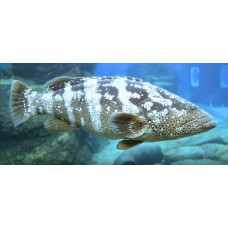Latin name
Epinephelus malabaricus
Other name
Blackspot rockcod, estuary rockcod, giant rock cod, greasy grouper, Malabar rockcod, Morgan's cod or speckled grouper.
Identification
Malabar grouper has ridged scales on body except cycloid scales on anterodorsal part, thorax and abdomen; body with additional scales; maximum body depth 3.0-3.6 inches across; head length 2.0-2.6 inches across; head length 2.3-2.6 times muzzle length; snout length 1.7-2.0 times maxillary length; width of interorbital spaces 4.5-6.5 times maxillary length and 2.1-3. 0 times the length of the upper jaw; flat or slightly convex interorbital area; subangular preorbital depression with enlarged denticles at the corners; almost straight upper margin of the eyelids; irregularly spaced posterior and anterior nostrils, except in large adults, in which the posterior nostrils are slightly larger; maxilla reaching or extending vertically at the posterior margin of the orbit, width of maxilla 4.5-6.5% of SL; length of maxilla 17-22% of SL, 2-5 rows of teeth in the mediolateral part of the mandible.
Features of fish fins
Dorsal spines (total): 11; Dorsal soft rays (total): 14 - 16; Anal spines: 3; Anal soft rays: 8. The caudal fin is rounded.
Fish colouring
Characterised by a pale grey or yellowish brown colour, five slightly oblique dark brown stripes that fork ventrally, and numerous small black patches and spots on the head and body.
Distribution
Widespread in the warm coastal waters of the Indian Ocean and western Pacific. In the west the species is found from the Red Sea to southern Africa, and in the east as far as Tonga and southern Japan. The species has been reported from the Haifa area of the Mediterranean.
Habitat
Tropical marine amphidromous species. Occurs to depths of 60m, sometimes 150m, in mangroves, lagoons and reefs in saline and brackish waters.
Size
These fish are 1-1.2 m long, rarely exceeding 2 m. The largest recorded specimen is 2.34 m long and weighs 150 kg.
Behavior
A common species inhabiting coral and rocky reefs, intertidal areas, estuaries, mangrove swamps on sandy or muddy bottoms. It is a solitary species. Juveniles have been found close to shore and in estuaries.
Food and feeding habits
Its diet is based on small fish and crustaceans, and less commonly on cephalopods.
Reproduction
Malabar groupers are hermaphrodites: each adult has both an ovary for egg production and glands for sperm production. This means that an individual can produce and fertilise its own eggs. All individuals are considered females at birth, but become males when they reach sexual maturity.
Fishing
It's a highly commercially important species.
Relationship with a person
Harmless. Introduced into live fish markets in Hong Kong. Widely used in mariculture, particularly in the Far East.
| Classification | |
| Phylum | Chordata |
| Class | Actinopterygii |
| Squad | Perciformes |
| Family | Serranidae |
| Genus | Epinephelus |
| Species | E. malabaricus |
| Features | |
| Conservation status | Least Concern |
| Habitat | Pelagic |
| Life span, years | No information |
| Maximum body weight, kg | 150 |
| Maximum length, cm | 234 |
| Sailing speed, m/s | No information |
| Threat to people | Edible |
| Way of eating | Predator |
Malabar grouper
Tags: malabar grouper

